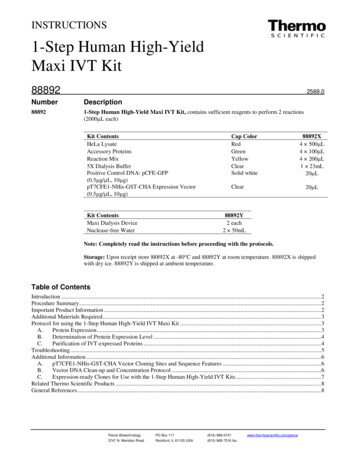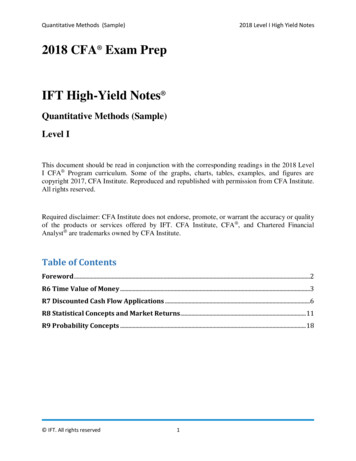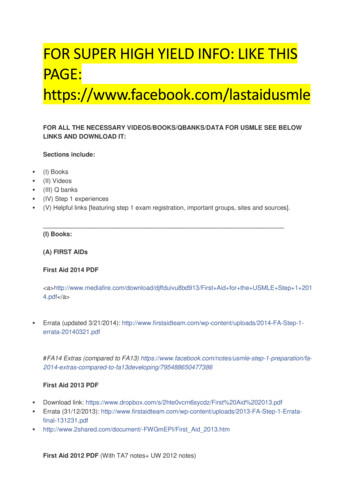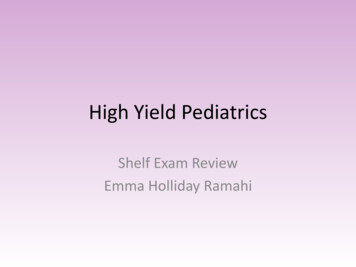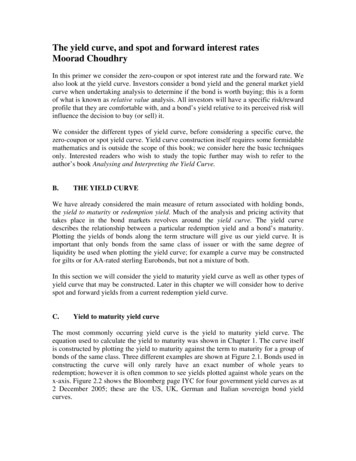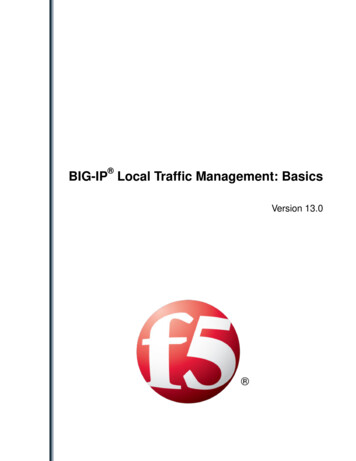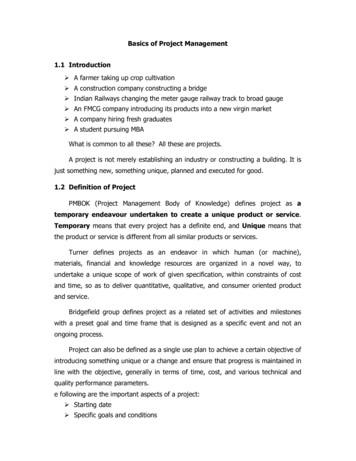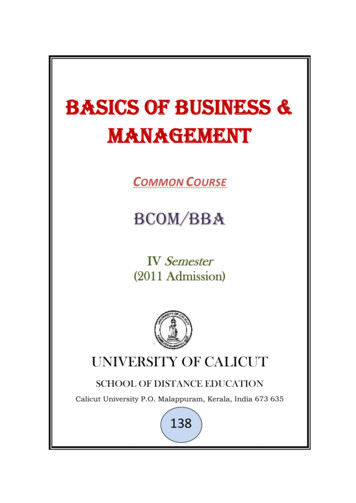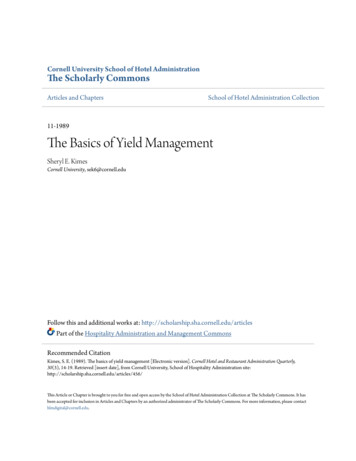
Transcription
Cornell University School of Hotel AdministrationThe Scholarly CommonsArticles and ChaptersSchool of Hotel Administration Collection11-1989The Basics of Yield ManagementSheryl E. KimesCornell University, sek6@cornell.eduFollow this and additional works at: http://scholarship.sha.cornell.edu/articlesPart of the Hospitality Administration and Management CommonsRecommended CitationKimes, S. E. (1989). The basics of yield management [Electronic version]. Cornell Hotel and Restaurant Administration Quarterly,30(3), 14-19. Retrieved [insert date], from Cornell University, School of Hospitality Administration 56/This Article or Chapter is brought to you for free and open access by the School of Hotel Administration Collection at The Scholarly Commons. It hasbeen accepted for inclusion in Articles and Chapters by an authorized administrator of The Scholarly Commons. For more information, please contacthlmdigital@cornell.edu.
The Basics of Yield ManagementAbstractYield-management systems have boosted revenue at many properties, but these electronic tools are not alwayscompatible with the operating atmosphere of a hotel. If you want to introduce yield management at yourproperty, you may need to make some changes first.Keywordshotel industry, yield management, revenue managementDisciplinesHospitality Administration and ManagementCommentsRequired Publisher Statement Cornell University. Reprinted with permission. All rights reserved.This article or chapter is available at The Scholarly Commons: http://scholarship.sha.cornell.edu/articles/456
The Basics ofYield ManagementYield-management systems have boosted revenue at many properties, but these electronictools are not always compatible with the operating atmosphere o f a hotel. If you want tointroduce yield management at your property, you may need to make some changes firstby Sheryl E. KimesYIELD MANAGEMENT is becoming part of the standard operating procedure for many hotelswith sophisticated electronic property-management systems. Appropriately tailored to the hotels theyserve, yield-management systemsgenerally increase revenue andtake much of the guesswork out ofrooms-management decisions.However, installing a yield-management system can create problems if management does not laythe proper groundwork. This article addresses the issues operatorsshould consider in determiningwhether yield management is rightfor their property and discussesSheryl E, Kimes is an assistant professor of quantitative methods at theSchool of Hotel Administration at Cornell University. She has a Ph.D. in operations managementfrom the University of Texas—Austin.14T H F r O R M F I I H R A O l iA R T F R I Y
some of the measures managersshould take to pave the way for successful adoption of such systems.What is Yield Management?Basically, yield management is theprocess of allocating the right typeof capacity to the right kind of customer at the right price so as tomaximize revenue or yield. In thecase of hotels, yield management isconcerned with the number ofrooms that should be sold at various rate levels. Obviously, a tradeoff exists. The manager would prefer to sell all rooms at the highestrate possible, but since this rarely isfeasible, following this policy maylead to empty rooms and lost revenue. Conversely, if a hotel fills itsrooms with low-price customers,the revenue that could have beenobtained from higher rates will belost. The objective of yield management, then, is to define what thesetrade-offs should be. How manyrooms should be allocated to andprotected for each market segmentover time?Or kin1defined the yield statisticas the occupancy rate multiplied bythe rate efficiency. The rate efficiency is the average room rate divided by the maximum room rate.As he points out, hotel managersneed to be concerned with maximizing yield, or revenue, ratherthan focusing only on a high occupancy rate or a high average roomrate. Another definition of yieldmanagement, borrowed from theairline industry, is maximizing revenue (or yield) per available room.This may be a more appropriatedefinition because of the difficultyin defining the maximum roomrate.Yield management consists oftwo separate but related parts:room-inventory management andpricing. The inventory-manage!Eric B. Orkin, “Boosting Your Bottom Linewith Yield Management ” The Cornell Hotel and Restaurant Administration Quarterly, 28, No. 4 (February 1988), pp. 5 2 -5 6 .N O V E M B E R 1M Qment process deals with how different types of rooms are to be allocated to demand. The pricingprocedure is more concerned withthe best prices to charge in different situations. In this article, I willconcentrate primarily on the roominventory component of yieldmanagement.Where Does YieldManagement Work?The airline industry is consideredthe birthplace of yield management. After deregulation in the late1970s, airline competition increased, and the airlines tried tooperate their planes as efficiently aspossible. Yield management wasone of the methods developed as away of increasing competitive advantage and increasing revenue. Inairlines, yield management is concerned with selling the right seat tothe right customer at the rightprice so as to maximize yield.The airline and hotel industrieshave several characteristics in common that make them ideal candidates for yield-management systems. Both have relatively fixedcapacities. Once an airplane hasbeen purchased or a hotel has beenbuilt, it is rather difficult and expensive to increase capacity. Theidea, then, is to use your capacity inthe best (most profitable) waypossible.Yield-management techniquesare appropriate when a firm is operating with a relatively fixed capacity, when demand can be segmented into clearly identifiedpartitions, when inventory is perishable, when the product is soldwell in advance, when demand fluctuates substantially, and when marginal sales costs are low but marginal production costs are high.Ability to segment markets. Fora yield-management program to beeffective, the firm must be able tosegment its market into differenttypes of customers. For example,For a yield-managementprogram to be effective, thefirm must be able to segmentits market into different typesof customers.
EXHIBIT 1Typical individual-sales booking curveRooms soldDays beforeThis booking pattern is typical of business-class hotels that cater to individual business travelers. Occasionally, business travelers book inadvance in anticipation of an upcoming meeting or conference. But it’s more common for business travelers to book a hotel room immediatelybefore a trip, either because the trip itself was scheduled on short notice in response to a specific need or because busy executives hesitate tobook ahead, not knowing if something more pressing might interfere with travel plans. When a hotel’s booking pattern approximates this curve,the yield-management system will discourage early bookings at lower rates and advise management to keep rooms available at higher, latebooking rates for the predictable high volume of last-minute reservations.business and pleasure travelers canbe split easily into separate groups.The basic idea is that hotel managers will have different marketingplans for the different types of customers. Hoteliers would like to beable to sell these segments roomsthat best fit their needs. In the caseof pleasure travelers, lower-pricedrooms that must be booked a certain length of time ahead may bemost appropriate. With businesstravelers, higher-priced rooms thathave no time penalty may work best.Perishable inventory. Clearly,hotel rooms are a perishable inventory item. If the room is not soldone night, that room-night is lostforever, and the hotel manager cannot put it into inventory for use atsome other time. Airlines andrental-car firms face similarproblems.Product sold in advance. Sometransient hotels sell most of theirrooms a few days in advance, but insome situations, reservations aremade well in advance of the day desired. In the case of group sales,reservations may be made severalyears in advance. When the product is sold in advance, the manageris faced with uncertainty. Should agroup that wants to pay a low ratebe accepted, or should the managerwait to see if higher-paying cus-tomers will appear? How many super-saver rooms should be sold?Might someone who would pay ahigher rate want to reserve thosesame rooms? With a good yieldmanagement system, these types ofquestions can be answered.Fluctuating demand. Hotels facewidely fluctuating demand patterns. Demand varies by season ofthe year, by day of the month, andby time of the week. Yield management can be used to help tempersome of the demand fluctuations byhelping to increase occupancy during slow times (by decreasing price)and by increasing revenue duringbusy times (by increasing price). IfT H F r O R M F I I H P A O IJ A R T F R I Y
EXHIBIT 2Typical group-business booking curveRooms soldDays beforeUnlike individual business travelers, groups generally make travel plans in advance to ensure that a hotel will have a sufficient number of roomsavailable to accommodate them. This booking pattern, typical of a hotel that caters to groups, shows that the hotel reserves over 70 percent of itsrooms a month or more in advance. By three weeks before a given date, the hotel has generally sold all but a handful of the rooms it will be ableto sell for that date. When a hotel’s booking history approximates this curve, the yield-management system will recommend accepting groupreservations well in advance at appropriate group rates.a manager knows when demandpeaks and valleys are going to occur, he or she will be better able toplan for them.Low marginal sales costs. Oncea certain number of rooms aresold, it does not cost much more tosell another room. The hotel andstaff are already in place, and onemore room does not make much ofa difference in terms of cost.High marginal productioncosts. Conversely, hotels face highmarginal production costs. For example, if a property is full and acustomer wants a room, anotherroom cannot easily be added ontothe property because of the largeN O V P M R P R -IQftQfixed cost. Hotels add capacity onlyin large chunks and only after demand patterns have been carefullystudied.Requirements of a YieldManagement SystemMany different types of yield-management systems exist, but most require the same sort of information.The hotel must know the pattern inwhich customers book reservations,must have good information on demand patterns by market segment,must have a defined overbookingpolicy, and must have an idea of theeffect of changing price on demand. Obviously, the hotel needs a17good information system thatkeeps the data easily accessible.Booking patterns. Most yieldmanagement systems require information on how reservations aremade for a particular day. For example, if the manager starts to lookat a particular night three monthsin advance, how many reservationscome in for each market segmenteach day? Exhibit 1 shows a hotel inwhich reservations are made nearthe day of arrival, while Exhibit 2shows a more group-based hotel inwhich reservations are generallymade long before the day of arrival. The yield-management system uses this information to help
Top management cannotassume that yieldmanagement will just“happen”; it requires carefulplanning and training.track how you are doing comparedto how you should be doing.Demand patterns by marketsegment. To operate any yieldmanagement system, a hotel musthave historical demand information available by market segment.This information must also be broken down by time of the year andday of the week. For example, howmany concierge rooms are usuallysold on Tuesday nights in the summer? How much does this usuallyvary? These historical data areused to build forecasts for each ofthe market segments. The demandforecast is one of the buildingblocks of yield management. Without it, the yield-management system cannot function properly.Overbooking policy. Most hotelshave some sort of overbooking policy. With a yield-management system, the overbooking policy shouldbe clearly stated. The level at whichmanagement is willing to overbookshould be built into the yield-management system.Effect of price changes. Themanager should have an idea ofhow changing price will affect thedemand for a particular class ofrooms. Airlines change prices several thousand times a day in response to competitive pressures.Clearly, this level of sophistication isbeyond that required for the average hotel operator, but still, themanager needs to be aware of competitive prices and what effect aprice change will have on demand.Good information system. Toobtain all of the information listedabove, the hotel must have an excellent information system. If the hotel is part of a central reservationsystem, the property-managementsystem and the central reservationsystem must be integrated. In thisway, as reservations are receivedand room availability changes, bothreservation systems will be awareof the latest information. Failure tohave this type of reservation systemcould lead to many problems, including selling rooms at too low aprice or not being aware of theavailability of certain types ofrooms.Specific Problems withHotel Yield ManagementYield-management techniques developed in the airline industry arenot always applicable to the hotelindustry. Yield-management systems for hotels need to address theproblems of multiple-night stays,the multiplier effect of rooms onother hotel functions (such as foodand beverage), the booking leadtimes for various types of rooms,the lack of a distinct rate structure,and decentralized informationsystems.Multiple-night stays. Airlineyield-management systems mustdeal with different flight legswithin a hub-and-spoke system,while hotels must deal with guestsstaying over multiple nights. If aguest wants to arrive on a low-demand day and stay through severalhigh-dem
management, borrowed from the airline industry, is maximizing rev-enue (or yield) per available room. This may be a more appropriate definition because of the difficulty in defining the maximum room rate. Yield management consists of two separate but related parts: room-inventory management and pricing. The inventory-manage-

